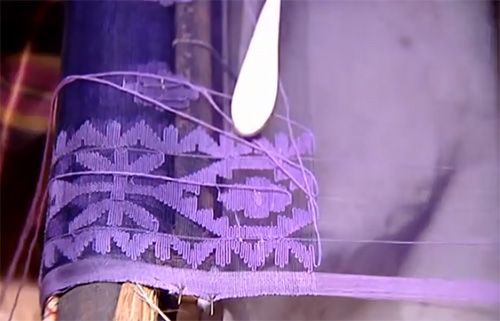 One of the most delicate and beautiful fabrics in the world, hand-woven on a loom, is a Jamdani – traditional muslin cloth of Bangladesh. This fabric is used today to make sarees, which serve as the folk clothing in this country. What’s interesting about Jamdani? For example, it takes 2 weavers to work simultaneously on one loom. Also, the craftsmen don’t draw their patterns before weaving – they, like, improvise.
One of the most delicate and beautiful fabrics in the world, hand-woven on a loom, is a Jamdani – traditional muslin cloth of Bangladesh. This fabric is used today to make sarees, which serve as the folk clothing in this country. What’s interesting about Jamdani? For example, it takes 2 weavers to work simultaneously on one loom. Also, the craftsmen don’t draw their patterns before weaving – they, like, improvise.
Jamdani weaving is one of the most time-consuming and labor-intensive forms of fabric production by hand on a traditional loom. The product from this style of weaving is called the “Jamdani” – a highly designed fabric that originated from the Dhakai muslin, the most transparent and delicate cotton cloth ever, woven by human hand. The Dhakai muslin derives its name from Dhaka.
During the reign of the Mughal Emperor Jahangir, from 1605 to 1627, the plain muslin was decorated with a wide range of floral designs. Emperor Jahangir is seen wearing a Jamdani sash around the waist. This flowered muslin came to be known as the Jamdani.

The original seat of Jamdani weaving was Sonargaon. Even though the fabulous Dhakai muslin became extinct, the Jamdani survived. The main reason for its survival was the increasing use of this fabric as a sari by all classes of Bengali women. The sari is the common dress for women in Bangladesh.
In the early 20th century, the seat of Jamdani weaving began shifting substantially from Sonargaon to Rupshi, which lies 5 miles southwest. Rupshi is now a region in Narayanganj district.

Jamdani weaving flourished in two sections: Kazipara and Noapara of Rupshi. Today, Jamdani weaving is found in Rupshi, Sonargaon, and Siddhirganj. Here, in Kazipara of Rupshi, there is a shop with 5 looms, where Jamdani fabric is produced. Its owner and one of the craftsmen here, Enamul Haque, has risen to mastery in Jamdani weaving. He is involved in the craft since 2000.

Five weaving looms in one room
Prior to actual weaving on the loom, there is a complex and tedious process of preparation, involving 9 groups of craftspeople, in addition to the weavers who make the largest group. All the 10 groups constitute a cohesive community, cherishing the skills and knowledge, which are being handed down from generation to generation.
We are again back to the shop of Enamul Haque and Shabuj Mia. In weaving a Jamdani, 2 weavers sit at a loom. This is how they weave a Jamdani sari. Once the Jamdani sari is done, a weaver coats it with starch made of parched rice. He cuts the sari from the end to separate it from the loom. Here is the finished product.

The Bangladesh Small and Cottage Industries Corporation (BSCIC) has established a township in the Noapara. Here, 420 families live. Each family has 10 to 20 looms under the roof of its dwelling. All family members are involved in Jamdani weaving. Boys and girls learn Jamdani weaving from their parents at their leisure.
The distinguishing hallmark of the Jamdani is that its designs are neither embroidered, nor printed, but created directly on the loom in the process of weaving. The weavers need not use any drawing – they weave design smoothly out of the patterns, stored in their minds. There are numerous designs which they have imitated from nature: from trees, creepers, foliage, flowers, fruits, and vegetables. Any design, that the weavers want to replicate, fuses readily into the fabric. As their hands move gracefully upon the loom, they concentrate on the task of the moment, blending the knowledge of the past with their hopes for the future.

Two craftsmen working at one loom
Amina Begum says: “I learned weaving from my husband. I feel proud of being a weaver. Our job is strenuous, yet I enjoy working at the loom. When we finish weaving a beautiful Jamdani sari, I become extremely happy, because it will adorn a woman who may be a bride or a fashion-loving lady. Yes, we give a strong consent for our exposure to people around the world”.
Most of the Jamdanis, woven weekly until Thursday, go to market on Friday. Both retailers and wholesalers are there to buy Jamdani directly from the weavers, who abstain from working on Friday.

Bangladeshi women in sarees made from Jamdani cloth
In Sonargaon, the original seat of Jamdani weaving, the Bangladesh Folk Arts and crafts Foundation has established here an emporium of Jamdani sarees.
Jamdani weaving is one of the most cherished elements of the intangible cultural heritage of Bangladesh. In the past, the world had the incredible experience of using Dhakai muslin, the finest cotton cloth ever known to humanity. The Jamdani is the surviving representation of that fabulous cotton cloth. Its exquisiteness and splendor lie in its woven designs of an infinite variety. Moreover, it is a technical marvel of handicraft, with creativity and ingenuity.

Jamdani sarees of various colors and patterns
(c)


